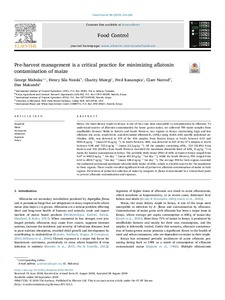| dc.contributor.author | Mahuku, George S. |
| dc.contributor.author | Nzioki, H.S. |
| dc.contributor.author | Mutegi, C. |
| dc.contributor.author | Kanampiu, F. |
| dc.contributor.author | Narrod, C. |
| dc.contributor.author | Makumbi, Dan |
| dc.date.accessioned | 2019-12-04T11:27:30Z |
| dc.date.available | 2019-12-04T11:27:30Z |
| dc.date.issued | 2019-02 |
| dc.identifier.citation | Mahuku, G., Nzioki, H.S., Mutegi, C., Kanampiu, F., Narrod, C. & Makumbi, D. (2019). Pre-harvest management is a critical practice for minimizing aflatoxin contamination of maize. Food Control, 96, 219-226. |
| dc.identifier.issn | 0956-7135 |
| dc.identifier.uri | https://hdl.handle.net/20.500.12478/4948 |
| dc.description | Published online: 8 Sept 2018; Open Access Article |
| dc.description.abstract | Maize, the main dietary staple in Kenya, is one of the crops most susceptible to contamination by aflatoxin. To understand sources of aflatoxin contamination for home grown maize, we collected 789 maize samples from smallholder farmers’ fields in Eastern and South Western, two regions in Kenya representing high and low aflatoxin risk areas, respectively, and determined aflatoxin B1 (AFB1) using ELISA with specific polyclonal antibodies. AFB1 was detected in 274 of the 416 samples from Eastern Kenya at levels between 0.01 and 9091.8 μg kg−1 (mean 67.8 μg kg−1). In South Western, AFB1 was detected in 233 of the 373 samples at levels between 0.98 and 722.2 μg kg−1 (mean 22.3 μg kg−1). Of the samples containing AFB1, 153 (55.8%) from Eastern and 102 (43.8%) from South Western exceeded the maximum allowable limit of AFB1 (5 μg kg−1) in maize for human consumption in Kenya. The probable daily intake (PDI) of AFB1 in Eastern Kenya ranged from 0.07 to 60612 ng kg−1 bw day−1 (mean 451.8 ng kg−1 bw day−1), while for South Western, PDI ranged from 6.53 to 4814.7 ng kg−1 bw day−1 (mean 148.4 ng kg−1 bw day−1). The average PDI for both regions exceeded the estimated provisional maximum tolerable daily intake of AFB1, which is a health concern for the population in these regions. These results revealed significant levels of preharvest aflatoxin contamination of maize in both regions. Prevention of preharvest infection of maize by toxigenic A. flavus strains should be a critical focal point to prevent aflatoxin contamination and exposure. |
| dc.description.sponsorship | Bill & Melinda Gates Foundation |
| dc.format.extent | 219-226 |
| dc.language.iso | en |
| dc.rights | CC-BY-4.0 |
| dc.subject | Maize |
| dc.subject | Preharvest Treatment |
| dc.subject | Aflatoxins |
| dc.subject | Kenya |
| dc.subject | East Africa |
| dc.title | Pre-harvest management is a critical practice for minimizing aflatoxin contamination of maize |
| dc.type | Journal Article |
| dc.description.version | Peer Review |
| cg.contributor.crp | Agriculture for Nutrition and Health |
| cg.contributor.crp | Climate Change, Agriculture and Food Security |
| cg.contributor.crp | Grain Legumes and Dryland Cereals |
| cg.contributor.crp | Roots, Tubers and Bananas |
| cg.contributor.affiliation | International Institute of Tropical Agriculture |
| cg.contributor.affiliation | Kenya Agricultural and Livestock Research Organization |
| cg.contributor.affiliation | University of Maryland |
| cg.contributor.affiliation | International Maize and Wheat Improvement Center |
| cg.coverage.region | Africa |
| cg.coverage.region | East Africa |
| cg.coverage.country | Kenya |
| cg.creator.identifier | George Mahuku: 0000-0001-8444-8651 |
| cg.creator.identifier | Charity Mutegi: 0000-0002-3188-0480 |
| cg.creator.identifier | Fred Kanampiu: 0000-0002-2480-6813 |
| cg.isijournal | ISI Journal |
| cg.authorship.types | CGIAR and developing country institute |
| cg.iitasubject | Maize |
| cg.journal | Food Control |
| cg.howpublished | Formally Published |
| cg.accessibilitystatus | Open Access |
| local.dspaceid | 102003 |
| cg.targetaudience | Scientists |
| cg.identifier.doi | https://dx.doi.org/10.1016/j.foodcont.2018.08.032 |

